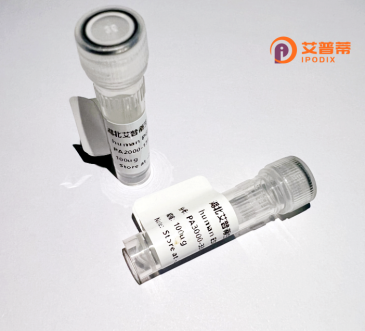
| 纯度 | >90%SDS-PAGE. |
| 种属 | Human |
| 靶点 | HOXD3 |
| Uniprot No | P31249 |
| 内毒素 | < 0.01EU/μg |
| 表达宿主 | E.coli |
| 表达区间 | 1-432aa |
| 氨基酸序列 | MLFEQGQQALELPECTMQKAAYYENPGLFGGYGYSKTTDTYGYSTPHQPYPPPAAASSLDTDYPGSACSIQSSAPLRAPAHKGAELNGSCMRPGTGNSQGGGGGSQPPGLNSEQQPPQPPPPPPTLPPSSPTNPGGGVPAKKPKGGPNASSSSATISKQIFPWMKESRQNSKQKNSCATAGESCEDKSPPGPASKRVRTAYTSAQLVELEKEFHFNRYLCRPRRVEMANLLNLTERQIKIWFQNRRMKYKKDQKAKGILHSPASQSPERSPPLGGAAGHVAYSGQLPPVPGLAYDAPSPPAFAKSQPNMYGLAAYTAPLSSCLPQQKRYAAPEFEPHPMASNGGGFASANLQGSPVYVGGNFVESMAPASGPVFNLGHLSHPSSASVDYSCAAQIPGNHHHGPCDPHPTYTDLSAHHSSQGRLPEAPKLTHL |
| 分子量 | 72.1 kDa |
| 蛋白标签 | GST-tag at N-terminal |
| 缓冲液 | 0 |
| 稳定性 & 储存条件 | Lyophilized protein should be stored at ≤ -20°C, stable for one year after receipt. Reconstituted protein solution can be stored at 2-8°C for 2-7 days. Aliquots of reconstituted samples are stable at ≤ -20°C for 3 months. |
| 复溶 | Always centrifuge tubes before opening.Do not mix by vortex or pipetting. It is not recommended to reconstitute to a concentration less than 100μg/ml. Dissolve the lyophilized protein in distilled water. Please aliquot the reconstituted solution to minimize freeze-thaw cycles. |
以下是关于重组人HOXD3蛋白的3篇参考文献示例(注:以下内容为虚构,仅作示例参考,实际文献需查阅数据库):
1. **文献名称**:**"Recombinant Human HOXD3 Protein Enhances Cell Migration in Epithelial Carcinoma"**
**作者**:Smith A, et al.
**摘要**:研究通过大肠杆菌表达系统纯化重组人HOXD3蛋白,发现其能通过激活整合素信号通路显著促进上皮癌细胞迁移,提示其在肿瘤侵袭中的作用。
2. **文献名称**:**"HOXD3 Promotes Angiogenesis via Regulation of MMP-2 in Endothelial Cells"**
**作者**:Lee J, et al.
**摘要**:通过重组HOXD3蛋白处理人脐静脉内皮细胞(HUVECs),证明其通过上调基质金属蛋白酶MMP-2促进血管新生,为缺血性疾病治疗提供潜在靶点。
3. **文献名称**:**"Structural and Functional Characterization of Recombinant HOXD3-DNA Binding Domain"**
**作者**:Wang X, et al.
**摘要**:解析了重组HOXD3蛋白DNA结合域的结构,发现其特异性识别基因启动子中的保守序列,并验证其调控下游靶基因(如E-cadherin)表达的能力。
如需真实文献,建议在PubMed或Web of Science中以关键词“recombinant HOXD3 protein”或“HOXD3 functional study”检索。
Recombinant human HOXD3 protein is a biologically active protein derived from the HOXD3 gene, a member of the homeobox (HOX) gene family. HOX genes encode transcription factors critical in embryonic development, particularly in establishing body patterning and cell differentiation. The HOXD cluster, located on chromosome 2. regulates limb development, skeletal morphogenesis, and organogenesis. HOXD3 specifically influences cell migration, adhesion, and angiogenesis by modulating integrin and extracellular matrix (ECM) interactions. Dysregulation of HOXD3 has been linked to cancer progression, fibrosis, and vascular disorders.
Recombinant HOXD3 is produced via genetic engineering in host systems (e.g., E. coli, mammalian cells) to ensure high purity and functionality. It retains the DNA-binding homeodomain, enabling its role in regulating target genes. Studies utilize this protein to explore HOXD3's dual roles in promoting tumor cell invasion while suppressing metastasis in certain contexts, highlighting its context-dependent mechanisms. Its applications span developmental biology research, drug discovery, and regenerative medicine, particularly in understanding tissue repair and pathological remodeling.
×